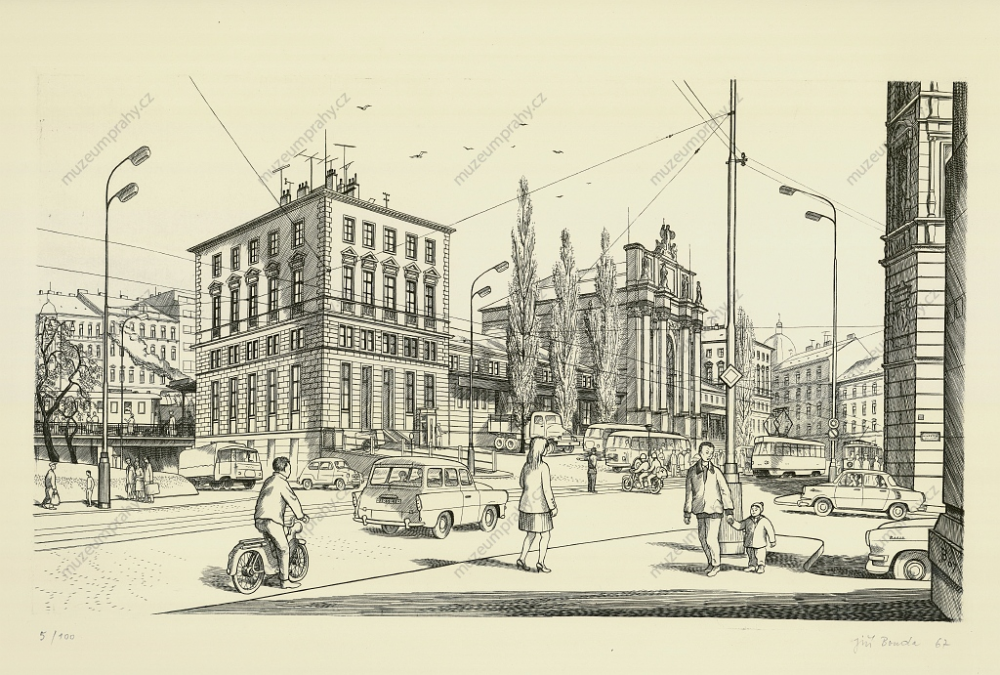
Anew station opened in Prague in May 1875. It was built by the Austrian Northwestern Railway, an important railway company which connected its large rail network with Prague two years earlier. Designed by architect Karel Schlimp, the impressive Neo-Renaissance building was presented aptly by Světozor Magazine in 1867: "The building is a sumptuous structure, very suitable for its purposes and very decorative for Prague". The central part of the station building was most monumental; its façade was patterned after the classical triumphal arch with four columns in the front which supported the statues of Trade, Science, Industry, and Economy. A group of figures representing Industry and Agriculture embellished the very top of the building, which was crowned by the allegorical sculpture of Austria. Similarly, the interior of the departure hall was also very sumptuous, as quoted in Světozor Magazine: "The emblems of the Northwestern Railway main stops are placed all around, with Prague and Vienna above the entrance, followed by Znojmo, Jihlava, Německý Brod, Kutná Hora, Kolín, Litoměřice, Ústí nad Labem, Děčín, Trutnov, Hostinné, Mladá Boleslav, Jičín, Hradec Králové, Chlumec, Nymburk, and Lysá on both sides. The Czech coats of arms were equipped with Czech signs and German emblems with German signs; the only exceptions were Lysá and Nymburk, which were accompanied with signs written in German. The emblems are painted tastefully. Furthermore, the vestibule features a large map of Austrian, German, and borderline countries. The waiting room for the first and second-class passengers shows an elegant style; seats are upholstered in green velvet and tables are made of marble. Splendid arabesques adorn the ceiling. The restaurant and waiting rooms for the third and fourth-class passengers are also decently furnished" (Světozor, 1876, No. 44, p. 591).
Primarily, this station was for passenger transport; a freight station had been established on the nearby Rohan Island. In 1919, Těšnov Station was renamed Denis Station after a French historian, politician, and expert on Slavism who significantly supported the origin of Czechoslovakia. During the German occupation, the station was first called Vltavské and later, after February 1948, Prague-Těšnov. In 1972, personal transport was discontinued; the northern wing of the building was demolished to make space for the North-South Arterial Road. On March 16, 1985, the remaining parts of the building were demolished without taking into account its architectural value and interesting possibilities of use.
Denis Station
Prague-Těšnov
Prague-Těšnov Station Depicted by Jiří Bouda
Decline and Demolition
July 1, 1972, was the last day Těšnov Station was in operation. In connection with the Prague railway network reconstruction and building of the new high capacity arterial road through the city centre, the station was shut down and the surroundings of Těšnov changed significantly during the 1970s and 1980s. In addition to Těšnov Station, the railway track Prague-Těšnov – Prague-Libeň (lower station) – Prague-Vysočany was also discontinued. Previous to 1975, the northern wing of the abandoned station building, standing in the way of the North-South Arterial Road, was demolished. The rest (central hall and southern wing) further deteriorated and served as the construction site facility. On March 16, 1985, after the building was deemed no longer needed, the remains of the building were blasted away. The suggestions to use the building for university or cultural purposes remained unheard whereas the political decision to raze the building won. The precious sculptural decoration (plus part of interior furnishings) was included in the City of Prague Museum collection. The area, which remained undeveloped, is a subject of more or less perspective architecture and urban planning.
